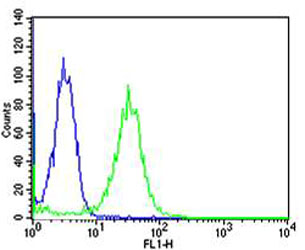

| WB | 1/1000 | Human,Mouse,Rat |
| IF | 咨询技术 | Human,Mouse,Rat |
| IHC | 咨询技术 | Human,Mouse,Rat |
| ICC | 技术咨询 | Human,Mouse,Rat |
| FCM | 1/25 | Human,Mouse,Rat |
| Elisa | 咨询技术 | Human,Mouse,Rat |
| Aliases | Transcription factor MafK, Erythroid transcription factor NF-E2 p18 subunit, MAFK |
| Entrez GeneID | 7975 |
| WB Predicted band size | 17.5kDa |
| Host/Isotype | Mouse IgG1 |
| Antibody Type | Primary antibody |
| Storage | Store at 4°C short term. Aliquot and store at -20°C long term. Avoid freeze/thaw cycles. |
| Species Reactivity | Human, Mouse, Rat |
| Immunogen | This MAFK antibody is generated from a mouse immunized with a KLH conjugated synthetic peptide between amino acids from the human region of human MAFK. |
+ +
以下是3条关于MAFK抗体的参考文献及其摘要概括:
---
1. **文献名称**:*"MafK overexpression in the retinal pigment epithelium contributes to diabetic retinopathy through antioxidant pathway dysregulation"*
**作者**:Li et al. (2020)
**摘要**:研究利用MAFK抗体通过Western blot和免疫组化分析,发现糖尿病视网膜病变中MAFK在视网膜色素上皮细胞异常高表达,导致抗氧化通路失衡,加剧氧化应激损伤。
---
2. **文献名称**:*"The role of MAFK in modulating NRF2-mediated oxidative stress response in hepatocellular carcinoma"*
**作者**:Saito et al. (2018)
**摘要**:通过ChIP-seq和免疫共沉淀实验(使用MAFK特异性抗体),揭示MAFK与NRF2竞争性结合抗氧化反应元件(ARE),影响肝癌细胞对化疗药物的耐药性。
---
3. **文献名称**:*"MAFK-driven transcriptional networks in macrophage polarization and inflammation"*
**作者**:Yamamoto et al. (2019)
**摘要**:利用MAFK抗体进行流式细胞术和免疫荧光染色,证明MAFK通过调控M2型巨噬细胞极化相关基因,参与炎症反应和纤维化疾病进程。
---
4. **文献名称**:*"MAFK is a regulator of the GABAergic neuronal phenotype in the developing brain"*
**作者**:Chen et al. (2021)
**摘要**:研究采用MAFK抗体进行染色质免疫沉淀(ChIP)和神经元特异性敲除模型,发现MAFK直接调控GABA能神经元分化关键基因,影响脑发育和功能。
---
以上文献均明确提及MAFK抗体的实验应用(如Western blot、免疫组化、ChIP等),并探讨MAFK在不同疾病或生理过程中的分子机制。
The MAFK antibody is a crucial tool in studying the MAF bZIP transcription factor K (MAFK), a member of the MAF family of leucine zipper proteins. MAFK functions as a transcription regulator, either activating or repressing target genes by forming homodimers or heterodimers with other MAF proteins, CNC family members (e.g., NRF2), or small musculoaponeurotic fibrosarcoma (sMAF) proteins. It plays roles in cellular differentiation, oxidative stress response, and tissue homeostasis, particularly in the liver, kidney, and immune cells. MAFK is implicated in diseases such as cancer, diabetes complications, and neurodegenerative disorders due to its involvement in pathways like the NRF2-mediated antioxidant response.
MAFK antibodies are widely used in techniques like Western blotting, immunohistochemistry (IHC), and chromatin immunoprecipitation (ChIP) to detect MAFK expression, localization, and DNA-binding activity. These antibodies help elucidate MAFK's regulatory mechanisms, including its interplay with NRF2 in cytoprotective gene expression. Commercial MAFK antibodies are typically validated for specificity and sensitivity across species (human, mouse, rat), with common host sources including rabbit and mouse. Researchers rely on these reagents to explore MAFK's dual role as an oncogene or tumor suppressor, depending on cellular context, and its potential as a therapeutic target in diseases linked to oxidative damage or aberrant proliferation.
×